Illustration is unique in that every artist has his or her own style. But in general, existing design styles can be refreshed and modernized when incorporated with aspects of more individualized design. Illustration is increasingly more integrated in design and is a great tool for creating something that’s truly unique.
Illustrative styles can be approached in a multitude of ways, but we’re going to share five that we think work especially well.
1. Contour Line
Contour line is the outline or silhouette of an object or figure, but can also be a continuous line that creates forms by not letting the pen leave the paper. This style is loose and defined more by its illustrative quality.

2. Line Style
Line style is an image composed solely of lines. Repetition and patterning are two techniques within this style that make up the illustration. Perspective is defined by the lines, which create depth and value.

3. Spot Color
Using a spot color is great for when you really want to incorporate color with line art. It can look like the color is outside the lines, but is a great technique for illustrations because that is normally the main focus. Color in this style supplements line. Color can even play the narrative when it takes on its own shape, so the lines making up the illustration are one element and the color as a shape is another element.

4. Cut Paper
Cut paper is dominated by shapes, with line being the supplement. It replicates the look of paper being layered to create an illustration. Color and shapes build the illustration in a way that’s very flat with color.

5. Patterns + Shapes
The last style is incorporating patterns and shapes minimally to accent text or a design. Using patterns and shapes in a repetitive way with color can be the perfect touch to accent a design or photograph to make it stand out.

